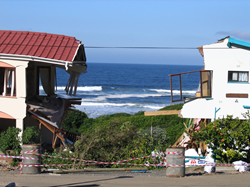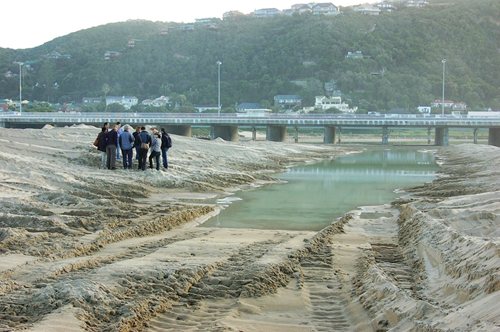 The purpose of the event was to provide a public platform for the exchange of knowledge and perceptions of vulnerabilities and risks in coastal areas. Members of the public and environmental researchers from several international institutes were invited to share stories of adaptations from three coastal areas: Cornwall (UK), Languedoc (France) and the Garden Route. A variety of stories provided an array of vulnerabilities and risks that laid the foundation for stimulating dialogues around the sustainability of coastal areas in times of rapid global change.
The purpose of the event was to provide a public platform for the exchange of knowledge and perceptions of vulnerabilities and risks in coastal areas. Members of the public and environmental researchers from several international institutes were invited to share stories of adaptations from three coastal areas: Cornwall (UK), Languedoc (France) and the Garden Route. A variety of stories provided an array of vulnerabilities and risks that laid the foundation for stimulating dialogues around the sustainability of coastal areas in times of rapid global change.
Stories from Cornwall
The case of Cornwall addressed the drastic increase in number of sea surges that have caused major floods of coastal homes in recent years. The presenting researchers described a process of ‘maladaptation’ by the local government, who responded by providing a financial compensation. The compensation was used as a short-term fix with a narrow focus on immediate flooding risks, but failed to alleviate vulnerability of the local community in the long-term.
Stories from Languedoc
A French team of researchers presented the salient environmental issues that currently impact the Languedoc coastal region and influence adaptive strategies by its inhabitants. The audience learned about degrading wetlands as the cause for a mosquito plaque which drives residents to take drastic ecologically-harmful measures. A second story outlined the changing farming practices in vineyards, as an adaptation to persistent draught conditions. Another example spoke of the current trajectories of coastal development by a growing amount of ‘newcomers’, who displace local impoverished communities and change the local ‘sense of place.’
Stories from Garden Route
Similar insights were brought to light by long-term residents of the Garden Route who expressed concerns about rapid urban development. Amongst these concerns is the role of residential properties on rivers, lakes and beaches in changing ecological dynamics and natural buffers to environmental disasters. This then links to the controversial artificial manipulation of the Touw River mouth.

A group of fisher ladies elaborated on their perception as a subsistence community whose livelihood has been drastically changed in the history of the Wilderness Lake area. The vulnerability of subsistence fishing communities is enhanced by overall declines in fish stocks, due to overfishing by trawlers. Moreover, nature conservation and private property owners increasingly restrict the access to common fishing grounds because of this issue. However, it has a large impact on the traditional ways of life of the subsistence fishers and exacerbates their economic vulnerability.
Conclusion
The audience at Wilderness Hotel expressed words of gratitude for having been part of a learning experience with international research institutes. The diversity of stories presented broadened an understanding of coastal risks and vulnerabilities, and how they can be driven by adaptive responses. It was particularly highlighted that the event stimulated the local public to think out of the box about the many facets that contribute to sustainability in coastal areas.